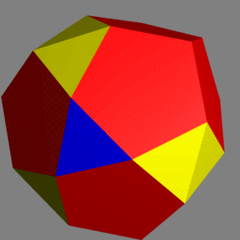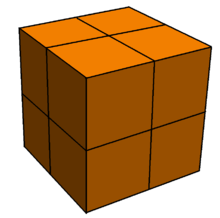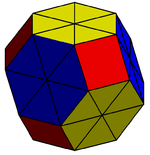Near-miss Johnson solid
In geometry, a near-miss Johnson solid is a strictly convex polyhedron, where every face is a regular or nearly regular polygon, and excluding the 5 Platonic solids, the 13 Archimedean solids, the infinite set of prisms, the infinite set of antiprisms, and the 92 Johnson solids.
The set of near-misses is not exactly defined, but can be loosely defined as convex polyhedra that can be approximately constructed from rigid regular polygon faces as a physical model. Because of the "fuzziness" of this definition, the exact number of near-misses is not known. [citation needed]
Examples
These four convex polyhedra can be modelled physically with regular polygon faces with various degrees of adjustment. If they could be built exactly, they would be Johnson solids.
| Name | Image | verfs | V | E | F | F3 | F4 | F5 | F6 | F8 | F10 | Symmetry |
|---|---|---|---|---|---|---|---|---|---|---|---|---|
| Truncated triakis tetrahedron |  |
4 (5.5.5) 24 (5.5.6) |
28 | 42 | 16 | 12 | 4 | Td | ||||
| -- |  |
6 (5.5.5) 9 (3.5.3.5) 12 (3.3.5.5) |
27 | 51 | 26 | 14 | 12 | D3h | ||||
| Tetrated dodecahedron |  |
4 (5.5.5) 12 (3.5.3.5) 12 (3.3.5.5) |
28 | 54 | 28 | 16 | 12 | Td | ||||
| -- |  |
12 (5.5.6) 6 (3.5.3.5) 12 (3.3.5.5) |
30 | 54 | 26 | 12 | 12 | 2 | D6h |
Possible vertex figures
The near-misses, like all convex polyhedra made of regular polygons, have a countably infinite set of vertex figures that they can use, defined by a positive angle defect. A secondary constraint for the triples requires the angle sum of the two smaller polygons to exceed the angle of the larger one.
The set of polygons that can create convex vertex figures include:
- Triples p.q.r:
- 3.3.(3-5), 3.4.(4-11), 3.5.(5-29), 3.6.(6+), 3.7.(7-41), 3.8.(8-23), 3.9.(9-17), 3.10.(10-14), 3.11.(11-13), 4.4.(4+), 4.5.(5-19), 4.6.(6-11), 4.7.(7-9), 5.5.(5-9), 5.6.(6-7).
- Quadruples p.q.r.s:
- 3.3.3.(3+), 3.3.4.(4-11), 3.3.5.(5-7), 3.4.4.(4-5)
- Quintuples p.q.r.s.t:
- 3.3.3.3.(3-5)
NOTE:
- (a-b) means any polygon for which the number of sides is between a and b inclusive.
- (n+) means any polygon with n or more sides.
Permutations of these polygon lists further extend possible vertex figures.
Each vertex figure has an angle defect, and a convex polyhedron will have a combined angle defect of 720 degrees.
These vertex figures and angle defect sums constrain the possible existence of convex polyhedra of regular or near regular polygon faces.
See Vertex configuration for the convex vertex figures used in the regular and semiregular solids.
Coplanar misses
Some failed Johnson solid candidates have coplanar faces. These polyhedra can be infintessimally adjusted to become convex with nearly regular polygon faces. These cases use 4.4.4.4 vertex figures of the square tiling, 3.3.3.3.3.3 vertex figure of the triangular tiling, as well as 60 degree rhombi divided double equilateral triangle faces, or a 60 degree trapezoid as three equilateral triangles.
Examples: 3.3...
-

(Rhombic prism)
-

Gyroelongated trigonal pyramid
-

-

-

-

4.4.4.4
-

Square icositetrahedron
(Cube)
3.4.6.4:
-

Hexagonal cupola
(Degenerate)
See also
- Platonic solid
- Semiregular polyhedron
- Johnson solids
- Geodesic dome
- Truncated rhombic dodecahedron
External links
- Near Misses
- <PDF> Symmetrohedra: Polyhedra from Symmetric Placement of Regular Polygons
- 24 Johnson Solid Near Misses








